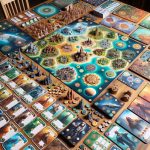Go game, also known as Weiqi in Chinese, Baduk in Korean, is a strategic board game that has been played for centuries. In this article, we will explore the intricate world of Go game strategy board games and delve into its history, rules, tactics, and techniques. Whether you’re a beginner looking to learn the basics or an experienced player wanting to sharpen your skills, understanding the nuances of Go game strategy is essential for success.
The origins of Go game can be traced back to ancient China and have since spread to various parts of the world, becoming a beloved pastime for many. The game’s simplicity lies in its complexity – with just a black and white stone set on a grid board, players engage in a battle of wits and strategize their moves meticulously to outmaneuver their opponent.
As one of the oldest board games still played today, Go game has stood the test of time due to its deep strategic elements that continuously challenge players.
Mastering the art of Go game strategy goes beyond just following the basic rules; it involves developing a keen sense of pattern recognition, anticipating your opponent’s next move, and strategically positioning your stones on the board. Strategy plays a crucial role in Go game, shaping every decision made by players and ultimately determining the outcome of each match. By studying advanced tactics and techniques, aspiring players can enhance their gameplay and strive for mastery in this timeless board game.
The History and Origins of Go Game
The game of Go, also known as Weiqi in China and Baduk in Korea, has a rich history that dates back thousands of years. It is believed to have originated in ancient China over 2,500 years ago, making it one of the oldest board games still played today. The exact origins of Go are shrouded in mystery, but it is said to have been created by a legendary Chinese emperor to teach his son discipline, balance, and strategic thinking.
Go spread to Korea and Japan in the following centuries, where it gained popularity among the nobility and eventually became a national pastime. In Japan, Go evolved into a highly respected art form, with professional players attaining celebrity status and competing in prestigious tournaments. The game’s profound influence on Asian culture cannot be overstated, as it is often used as a metaphor for life itself due to its intricate strategies and philosophical underpinnings.
Throughout its long history, Go has undergone numerous changes and adaptations while still maintaining its core principles. The game has stood the test of time and continues to captivate players worldwide with its blend of simplicity and depth. Whether you are a beginner learning the basics or an experienced player honing your skills, delving into the history of Go can provide valuable insights into the game’s enduring appeal.
| Key Fact | Description |
|---|---|
| Origin | Go originated in ancient China over 2,500 years ago. |
| Cultural Significance | Go has become deeply ingrained in Asian culture as a symbol of strategy and philosophy. |
| Evolution | The game has evolved over time but maintains its fundamental principles. |
Understanding the Basic Rules of Go Game
Go Game, also known as Baduk or Weiqi, is a traditional strategy board game that originated in China more than 2,500 years ago. Over the centuries, it has gained immense popularity not just in East Asia but across the globe. Understanding the basic rules of Go Game is essential for anyone looking to delve into this intricate and fascinating world of strategic gameplay.
To play Go Game, all you need is a 19×19 grid board (known as Goban) and two sets of stones, typically black and white. The objective of the game is to capture territory by surrounding vacant points on the board. Players take turns placing their stones on the intersecting points (called ‘intersections’) on the board, aiming to dominate more territory than their opponent.
In Go Game, there are a few fundamental rules to keep in mind:
- Players alternate turns placing one stone at a time
- Stones placed on the board cannot be moved unless captured
- Stones can capture enemy stones by completely surrounding them
- Suicide moves (placing a stone that would be immediately captured) are not allowed
By grasping these basic rules and concepts of Go Game, players can start developing strategies and tactics to outmaneuver their opponents on the board. Whether you’re a beginner or seasoned player, mastering these foundational rules is crucial for building a strong foundation in your Go Game strategy skills.
Importance of Strategy in Go Game
The game of Go, also known as Weiqi in China and Baduk in Korea, is renowned for its intricate gameplay and emphasis on strategic thinking. The Importance of Strategy in Go Game cannot be overstated, as it is the key element that separates casual players from skilled masters. In the world of board games, Go stands out for its deep strategic complexity and the need for players to constantly adapt and anticipate their opponent’s moves.
To excel at Go Game requires a deep understanding of the game’s basic rules and mechanics, but it is truly mastery of strategy that sets great players apart. Here are some fundamental strategies that beginners can employ to improve their game:
1. Control the Center: In Go, controlling the center of the board is crucial as it allows for flexibility in expanding territory while restricting your opponent’s options.
2. Influence vs Territory: Players must strike a balance between building influence (potential territory) and securing actual territory on the board to ensure a well-rounded strategy.
3. Balance offense and defense: Knowing when to switch between offensive moves to expand your own territory and defensive moves to protect against your opponent’s encroachments is essential in maintaining control of the game.
As players progress in their Go Game journey, they will discover more advanced tactics and techniques that can be applied to outmaneuver opponents effectively. By continuously honing their strategic skills through practice and study, players can reach higher levels of play and truly appreciate the depth and beauty of this ancient board game.
Advanced Tactics and Techniques for Winning at Go Game
Corner Enclosures
One of the key tactics in Go game strategy is corner enclosures. This involves creating a solid formation in the corners of the board to secure territory and establish a strong position for future moves. By controlling the corners, players can start to build influence towards the center of the board while denying their opponent vital territory. It is essential to balance corner enclosures with flexibility, as overcommitting to one area can leave vulnerabilities elsewhere on the board.
Influence and Territory Expansion
In Go game strategy, understanding influence and territorial expansion is crucial for success. Influence refers to the power a player’s stones have over specific areas of the board, while territorial expansion involves claiming and securing as much territory as possible.
Players must strategically balance these two elements throughout the game, adapting their tactics based on their opponent’s moves and board position. By carefully assessing influence and territory expansion, players can create interconnected groups of stones that work together efficiently towards victory.
Sacrifice and Sacrifice Ploys
Another advanced technique in Go game strategy is sacrifice tactics and ploys. Sacrifices are deliberate moves where a player willingly gives up stones or territory to gain an advantage elsewhere on the board. Sacrifice ploys involve deceptive maneuvers that appear to be sacrifices but actually set up advantageous sequences or traps for opponents.
Mastering sacrifice tactics requires foresight, calculation, and a deep understanding of positional play in Go game. By using sacrifices strategically, players can manipulate their opponent’s actions, control crucial areas of the board, and ultimately secure victory.
Famous Go Game Players and Their Strategies
Go game, a strategic board game originating from ancient China, has gained popularity worldwide for its depth and complexity. Over the years, there have been several renowned Go players who have showcased exceptional skills and strategies in mastering this game. One of the most famous Go players is Honinbo Shusaku, a Japanese player from the 19th century known for his innovative strategies and precise moves during gameplay. His legacy continues to inspire Go enthusiasts to this day.
Another legendary figure in the world of Go is Lee Chang-ho from South Korea, often referred to as “The Stone Buddha” for his calm demeanor and unwavering focus during matches. Lee Chang-ho’s strategic prowess lies in his ability to adapt to different playing styles, making him a formidable opponent on the board. His strategic mindset and flawless execution of tactics have earned him numerous accolades and titles throughout his career.
In addition to Honinbo Shusaku and Lee Chang-ho, other notable Go players such as AlphaGo, a computer program developed by DeepMind Technologies, have revolutionized the game with their unique strategies. AlphaGo’s utilization of artificial intelligence algorithms has changed the landscape of competitive Go play, showcasing that strategy can be approached in diverse ways.
Overall, studying the strategies employed by these famous players can provide valuable insights for individuals looking to enhance their own tactics in Go game or other board games with similar mechanics.
| Famous Player | Country |
|---|---|
| Honinbo Shusaku | Japan |
| Lee Chang-ho | South Korea |
| AlphaGo | N/A (Computer Program) |
How Go Game Strategy Relates to Other Board Games
When it comes to board games, strategy is often a key component in achieving victory. The same holds true for Go Game, a traditional Asian board game that requires careful planning and foresight to outmaneuver opponents. Understanding how Go Game strategy relates to other board games can provide valuable insights and enhance gameplay across different genres.
Common Elements of Strategy
Whether playing Go Game, chess, or even modern strategy board games, certain fundamental elements of strategy tend to remain consistent. These include concepts such as controlling the board, anticipating opponent moves, and adapting tactics based on changing circumstances. By recognizing these shared principles, players can transfer their strategic skills between different games and improve their overall gameplay abilities.
Differences in Gameplay Mechanics
Despite these common elements, each board game has its own unique mechanics and strategies that set it apart from others. For example, while chess focuses heavily on positional tactics and piece value, Go Game emphasizes territory control and influence over the board. Understanding these distinctions can help players appreciate the nuances of different games and develop diverse strategic thinking abilities that can be applied across various gaming platforms.
Cross-Training Benefits
For individuals looking to sharpen their strategic prowess, exploring a variety of board games can offer cross-training benefits that enhance overall gameplay performance. By studying the strategies employed in Go Game alongside those used in other board games, players can gain a broader perspective on strategic thinking and improve their decision-making skills in a holistic manner.
This cross-pollination of ideas not only enriches gameplay experiences but also cultivates a deeper appreciation for the art of strategic gaming as a whole.
Resources for Improving Your Go Game Strategy Skills
Mastering the art of Go game strategy can be a challenging yet rewarding experience for players looking to improve their skills in this ancient and highly strategic board game. Fortunately, there are numerous resources available to help enthusiasts enhance their understanding and ability to develop winning strategies in Go.
One of the most valuable resources for improving Go game strategy skills is studying classic games played by master players. By analyzing the moves, patterns, and decision-making processes of expert players, aspiring Go enthusiasts can gain valuable insights into effective strategies that can be implemented in their own gameplay. Many professional matches are widely available online or in books, providing a wealth of knowledge for those looking to elevate their strategic thinking in Go.
In addition to studying historic games, practicing regularly with experienced players or online opponents can also greatly contribute to improving one’s Go game strategy skills. Engaging in friendly matches allows players to test out different tactics, learn from their mistakes, and adapt their strategies based on the outcomes of each game. This hands-on approach not only helps sharpen one’s strategic thinking but also provides practical experience that is essential for mastering the complexities of Go.
Furthermore, attending workshops, seminars, or Go game strategy classes led by skilled instructors can offer valuable guidance and personalized feedback for players looking to enhance their strategic abilities in Go. These educational resources typically delve into advanced tactics, reading exercises, positional judgment, and other key aspects of strategic gameplay that can help players refine their skills and become more proficient at predicting opponents’ moves and developing winning strategies in the game.
By actively seeking out these opportunities for learning and growth, players can continue to strengthen their Go game strategy skills and ultimately become more competitive and successful in their gameplay.
Conclusion
In conclusion, mastering the art of Go Game strategy involves a deep understanding of not only the basic rules but also the complex tactics and techniques that can lead to victory. The game’s rich history and origins provide a fascinating backdrop for players looking to delve deeper into the world of strategic board games. By studying famous Go Game players and their strategies, one can gain valuable insights into how to approach this challenging game.
It is important for players to constantly seek ways to improve their Go Game strategy skills by exploring resources that offer advanced techniques and tactics. Whether through books, online tutorials, or in-person lessons, there are numerous avenues available for those looking to enhance their gameplay. Additionally, understanding how Go Game strategy relates to other board games can provide a fresh perspective and potentially unlock new strategies.
In the ever-evolving landscape of board games, Go Game remains a timeless classic that continues to captivate players with its depth and complexity. By honing their strategic skills and delving into the nuances of this ancient game, players can embark on a rewarding journey towards mastery. So, whether you are a seasoned player or just starting out, embracing the challenge of mastering Go Game strategy can lead to hours of enjoyable gameplay and endless opportunities for growth.
Frequently Asked Questions
What Is the Strategy of the Board Game Go?
The strategy of the board game Go involves capturing your opponent’s stones by surrounding them with your own. It also includes controlling territory on the board and creating strong, connected groups of stones to maintain influence. Players must balance offense and defense to outmaneuver their opponents.
Is Go More Difficult Than Chess?
Many people consider Go to be more difficult than Chess due to its complexity and the larger board size. While Chess has simpler rules and pieces with different movements, Go offers a unique challenge with its open-ended possibilities and strategic depth that can be intimidating for beginners.
What Games Can Be Played on a Go Board?
A variety of games can be played on a Go board besides the traditional game of Go itself.
Some examples include Pente, where players aim to get five stones in a row before their opponent; Connect6, which involves connecting six stones in a row instead of five; or even simple games like Dots and Boxes using the grid lines on the board as a playing field for different types of fun challenges.

I love playing all kinds of games – from classics like Monopoly to modern favourites like Ticket to Ride.
I created this blog as a way to share my love of board games with others, and provide information on the latest releases and news in the industry.





